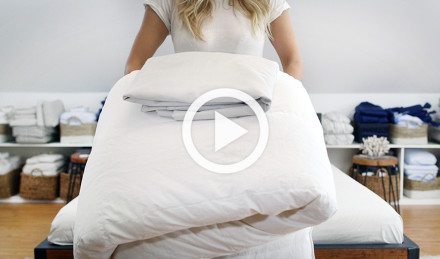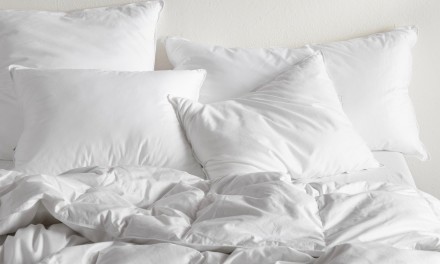Sateen sheets can instantly transform any bedroom into a sophisticated sanctuary. But proper care is key to keeping the signature matte sheen surface silky smooth for years. Sateen sheets are easy to care for at home, unlike silk or satin sheets that may require special handling.
Sateen does have its particularities, though. For example, to maintain a wrinkle-free look, it’s essential to remove sheets from the dryer as soon as the cycle is finished.
Keep reading for a breakdown of best practices for sateen sheet care. We’ll show you everything from how to wash cotton sateen sheets with the perfect settings to tips for getting stains out of sateen.
Washing Sateen Sheets
Before putting your sateen sheets in the washer, always read the care instructions listed on the label. While sateen bedding is made from cotton, you still need to be careful when you wash it to avoid shrinking, color fading and pilling.
You can learn everything there is to know about this luxury fabric in our sateen bedding guide.
Washing Sateen Sheets
Before putting your sateen sheets in the washer, always read the care instructions listed on the label. While sateen bedding is made from cotton, you still need to be careful when you wash it to avoid shrinking, color fading and pilling.
You can learn everything there is to know about this luxury fabric in our sateen bedding guide.
Pre-Wash Preparation
Washing your bedding before making your bed will only make them softer and more comfortable -- especially over time. When you wash, don’t overfill your washer with other bedding items or clothing. Extra items will inevitably get entangled with your sheets, resulting in a less effective washing cycle and could even cause damage to the fibers.
Pre-Wash Preparation
Washing your bedding before making your bed will only make them softer and more comfortable -- especially over time. When you wash, don’t overfill your washer with other bedding items or clothing. Extra items will inevitably get entangled with your sheets, resulting in a less effective washing cycle and could even cause damage to the fibers.
What Temperature to Wash Sateen Sheets
Now that you’ve placed your linens in the washer, do you wash sateen sheets in cold or hot water? The correct answer is somewhere in the middle. Cool water is best for sateen bedding. Hot water can cause thread damage or shrinkage, while cold water might not properly clean the fabric.
What Temperature to Wash Sateen Sheets
Now that you’ve placed your linens in the washer, do you wash sateen sheets in cold or hot water? The correct answer is somewhere in the middle. Cool water is best for sateen bedding. Hot water can cause thread damage or shrinkage, while cold water might not properly clean the fabric.
What Settings to Wash Sateen Sheets
While each washing machine has its own quirks, washing your sateen sheets with the delicate setting is your safest bet. You can also try the normal setting, but adjust the water temperature to cool first, and the spin cycle to low. Certain washing machines also have a bedding setting.
Always use a mild detergent free of bleaching agents. And, speaking of bleaching agents, never use bleach on your sateen sheets, even if they’re white. Because sateen is made from naturally soft egyptian-cotton, you also don’t need to use fabric softener when you wash your bed sheets.
What Settings to Wash Sateen Sheets
While each washing machine has its own quirks, washing your sateen sheets with the delicate setting is your safest bet. You can also try the normal setting, but adjust the water temperature to cool first, and the spin cycle to low. Certain washing machines also have a bedding setting.
Always use a mild detergent free of bleaching agents. And, speaking of bleaching agents, never use bleach on your sateen sheets, even if they’re white. Because sateen is made from naturally soft egyptian-cotton, you also don’t need to use fabric softener when you wash your bed sheets.
How to Get Stains Out of Sateen Sheets
Accidental spills happen, so be prepared to give your bedding some extra attention. Stains on sateen sheets should be treated immediately or as soon as you notice them.
Apply a non-bleach stain remover directly on the stained area. Then wash your sheets as you normally would.
If the stains are bigger or have already dried, soak the bedding for a few hours in cool water with some mild detergent and put them through a normal wash cycle -- the soaking loosens the stains while the detergent removes them.
Expensive products to treat sateen bed sheets aren’t necessary. White vinegar is known for its odor and stain-removing properties. You can use it even on delicate fabrics such as linen and silk. Soak sateen sheets in cool water mixed with a third of a cup of white vinegar. You can also add the vinegar directly to the fabric softener tray of the washing machine.
Another great pantry ingredient that works miracles for stained sateen bed sheets is baking soda. It boosts your detergent’s effectiveness and acts as a natural bleacher without damaging the cotton fibers of the fabric. Place half a cup of baking soda directly in the drum and then use as much mild detergent as you normally would.
How to Get Stains Out of Sateen Sheets
Accidental spills happen, so be prepared to give your bedding some extra attention. Stains on sateen sheets should be treated immediately or as soon as you notice them.
Apply a non-bleach stain remover directly on the stained area. Then wash your sheets as you normally would.
If the stains are bigger or have already dried, soak the bedding for a few hours in cool water with some mild detergent and put them through a normal wash cycle -- the soaking loosens the stains while the detergent removes them.
Expensive products to treat sateen bed sheets aren’t necessary. White vinegar is known for its odor and stain-removing properties. You can use it even on delicate fabrics such as linen and silk. Soak sateen sheets in cool water mixed with a third of a cup of white vinegar. You can also add the vinegar directly to the fabric softener tray of the washing machine.
Another great pantry ingredient that works miracles for stained sateen bed sheets is baking soda. It boosts your detergent’s effectiveness and acts as a natural bleacher without damaging the cotton fibers of the fabric. Place half a cup of baking soda directly in the drum and then use as much mild detergent as you normally would.
How Often to Wash Sateen Sheets
It’s essential to wash your bed linens often to maintain a healthy and clean sleep environment. Most bed sheets should to be washed at least once a week, and that includes sateen bedding. Of course, this can be adjusted according to your lifestyle. The general rule of thumb is not to sleep in the same set of sheets for more than seven to eight days.
If you have been sick with the flu or have had a cold, wash your sheets as soon as you feel better. People with asthma or those with very sensitive skin should also wash their bedding more often.
How Often to Wash Sateen Sheets
It’s essential to wash your bed linens often to maintain a healthy and clean sleep environment. Most bed sheets should to be washed at least once a week, and that includes sateen bedding. Of course, this can be adjusted according to your lifestyle. The general rule of thumb is not to sleep in the same set of sheets for more than seven to eight days.
If you have been sick with the flu or have had a cold, wash your sheets as soon as you feel better. People with asthma or those with very sensitive skin should also wash their bedding more often.
How to Dry Sateen Sheets
Once your sateen sheets are washed, immediately transfer them to the dryer to prevent wrinkles or mold. Never dry bed sheets at the highest setting. Hot air can damage the cotton fibers, making them prone to tearing. It can also cause color fading, shrinking and pilling.
For optimal results, tumble dry low. Instead of using dryer sheets made with chemicals and synthetic fragrances, try placing a few wool dryer balls in with your sheets. They’re a healthier, natural substitute to dryer sheets. They can also cut drying time in half, making them a more sustainable option.
To learn more about dryer balls, check out our guide, Do Dryer Balls Really Work.
If you have a backyard, there are many advantages to setting up a clothesline and hanging your sheets to air dry. Your sheets will smell and feel naturally fresh, you’ll save energy and money, and extend the lifespan of your sateen bedding.
How to Dry Sateen Sheets
Once your sateen sheets are washed, immediately transfer them to the dryer to prevent wrinkles or mold. Never dry bed sheets at the highest setting. Hot air can damage the cotton fibers, making them prone to tearing. It can also cause color fading, shrinking and pilling.
For optimal results, tumble dry low. Instead of using dryer sheets made with chemicals and synthetic fragrances, try placing a few wool dryer balls in with your sheets. They’re a healthier, natural substitute to dryer sheets. They can also cut drying time in half, making them a more sustainable option.
To learn more about dryer balls, check out our guide, Do Dryer Balls Really Work.
If you have a backyard, there are many advantages to setting up a clothesline and hanging your sheets to air dry. Your sheets will smell and feel naturally fresh, you’ll save energy and money, and extend the lifespan of your sateen bedding.
Post-Wash Care Tips for Sateen Bedding
Sateen sheets are naturally wrinkle-resistant. The reason is their unique weaving pattern -- it produces a thicker fabric that drapes beautifully and is less prone to creasing.
Post-Wash Care Tips for Sateen Bedding
Sateen sheets are naturally wrinkle-resistant. The reason is their unique weaving pattern -- it produces a thicker fabric that drapes beautifully and is less prone to creasing.
Ironing
The best and most effective way to iron sateen bedding is to take it out of the dryer while still slightly damp. Then iron the bedsheets on the reverse side, according to the instructions on their label.
A helpful time-saving trick for a fitted sateen sheet is to fit it on your mattress while damp. By the time it's dry, it will be wrinkle-free.
Ironing
The best and most effective way to iron sateen bedding is to take it out of the dryer while still slightly damp. Then iron the bedsheets on the reverse side, according to the instructions on their label.
A helpful time-saving trick for a fitted sateen sheet is to fit it on your mattress while damp. By the time it's dry, it will be wrinkle-free.
Storage
It is essential to store sateen bed linens properly to protect them from mold, mildew and discoloring. Once you’ve dried and folded the bedsheets, place them in a cool, dry place away from the sun. Good ventilation is a must. If you only use sateen bedding during colder months, place them in a cotton bag in springtime to keep dust and other airborne pollutants away.
To keep sateen bedsheets clean for longer, try to keep pets away from the bedroom and avoid placing outerwear such as jackets and coats or bags on them.
Storage
It is essential to store sateen bed linens properly to protect them from mold, mildew and discoloring. Once you’ve dried and folded the bedsheets, place them in a cool, dry place away from the sun. Good ventilation is a must. If you only use sateen bedding during colder months, place them in a cotton bag in springtime to keep dust and other airborne pollutants away.
To keep sateen bedsheets clean for longer, try to keep pets away from the bedroom and avoid placing outerwear such as jackets and coats or bags on them.
Where to Shop for High-Quality Sateen Bedding?
At Parachute, you’ll find sateen bedding crafted from premium long-staple Egyptian cotton. The Oeko-Tex-certified bedsheets and pillowcases at Parachute are made by expert artisans in a family-owned factory, in the Guimarães region of northern Portugal.
And remember, even though our luxury bedding is built to last, the best way to prolong their life is to machine-wash them in cool water, using natural laundry detergent. Tumble dry low with a few wool dryer balls made from premium New Zealand Wool. The wool balls will prevent them from wrinkling, and will neutralize static electricity and cling.
With proper care, the sateen bed linens you’ll discover at Parachute have that luxurious, ultra-soft feel and will last for years.
Read on:
Household Chore List: Daily, Weekly, Monthly Chores Around the House
Laundry Room Essentials: Everything You Need for Doing Laundry
When to Replace Sheets, Pillows, Blankets, & More Household Essentials
When to Replace Towels, Bath Mats, Shower Curtain Liners, & Other Bath Essentials
How to Recycle, Reuse, & Donate Old Sheets, Blankets, & Towels
Where to Shop for High-Quality Sateen Bedding?
At Parachute, you’ll find sateen bedding crafted from premium long-staple Egyptian cotton. The Oeko-Tex-certified bedsheets and pillowcases at Parachute are made by expert artisans in a family-owned factory, in the Guimarães region of northern Portugal.
And remember, even though our luxury bedding is built to last, the best way to prolong their life is to machine-wash them in cool water, using natural laundry detergent. Tumble dry low with a few wool dryer balls made from premium New Zealand Wool. The wool balls will prevent them from wrinkling, and will neutralize static electricity and cling.
With proper care, the sateen bed linens you’ll discover at Parachute have that luxurious, ultra-soft feel and will last for years.
Read on:
Household Chore List: Daily, Weekly, Monthly Chores Around the House
Laundry Room Essentials: Everything You Need for Doing Laundry
When to Replace Sheets, Pillows, Blankets, & More Household Essentials
When to Replace Towels, Bath Mats, Shower Curtain Liners, & Other Bath Essentials
How to Recycle, Reuse, & Donate Old Sheets, Blankets, & Towels






